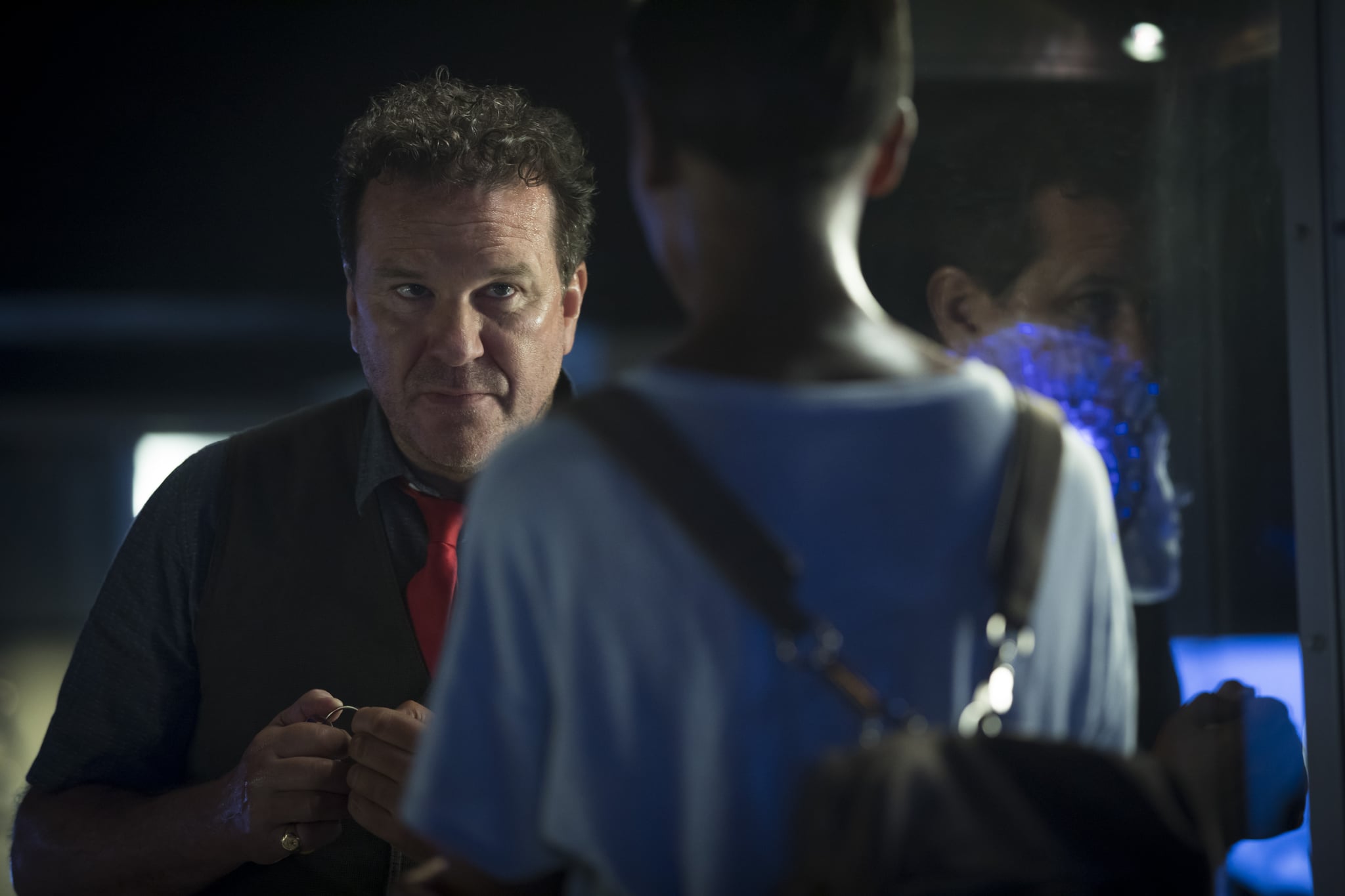 Image Source: Netflix [1]
Image Source: Netflix [1]
Warning: a ton of spoilers for Black Mirror below!
If you watched Black Mirror [2]'s excellent fourth season [3] in the intended order, then you know it ends with an episode jam-packed with Easter eggs: "Black Museum." The 70-minute dystopian tale follows a young woman (Letitia Wright) whose car runs out of petrol outside a museum full of oddities, called "The Black Museum." Once inside, proprietor Rolo Haynes (Douglas Hodge) tells her stories relating to each of the disturbing artefacts — most from previous season four episodes — on display.
There's the iPad from "Arkangel [4]," the bloody bathtub from "Crocodile," and the DNA scanner from "USS Callister [5]," among others. What's interesting is that "Black Museum" also has a few references to other seasons of Black Mirror: one of the tiny solar-powered bug robots from season three's "Hated in the Nation," a dummy wearing a mask from season two's "White Bear," and a glimpse of Carlton Bloom from season one's "National Anthem."
"Black Museum" is far from the only one to contain connections to previous instalments — it's just the most obvious.
It's not the first time Charlie Brooker's sci-fi drama has dropped subtle nods to previous episodes here and there — take the song that plays in every season [6], for example — but it definitely feels like more than a collection of tenuous Easter eggs this time; "Black Museum" is pretty much a confirmation that all of Black Mirror's episodes have been taking place in the same universe this whole time. When you really start to take a closer look at the last six episodes, "Black Museum" is far from the only one to contain connections to previous instalments — it's just the most obvious.
From common instances of futuristic technology to other telling nods, let's break down a few of season four's most convincing links to the rest of Black Mirror. Buckle up, because it's going to be one crazy ride.
 Image Source: FX
Image Source: FX
"Cookie" Technology
In "Black Museum" Rolo relays much of his history as an employee of the company TCKR to Nish. During this, he hints that he laid the groundwork for TCKR's "cookie" technology, which is heavily featured in season two's holiday special, "White Christmas." That bleak-as-hell episode introduces us to small implants that sit in your brain for a week, soaking up everything it is that makes you you before being taken out and put into Alexa-like [8] devices to help organise your life (of course, they can also be used by police to extract information from an unwilling suspect and otherwise manipulate a replica of someone's consciousness). The shady tech company that Rolo worked for is clearly responsible for birthing that device, as well as many, many others.
The Existence of TCKR
Nish makes a comment about "uploading old people to the Cloud" in "Black Museum," which is most certainly a reference to the plot of the lovely "San Junipero." [9] In it, two young women appear to fall in love in a seaside town called "San Junipero" in 1987, before it's actually revealed that the town is a simulated reality where elderly people can temporarily visit and the digital consciousnesses of the deceased can live permanently. That's not the only "San Junipero" reference, though.
In the second vignette of "Black Museum," a man's wife gets hit by a van and ends up in a coma. The hospital where she's staying, and the one where Rolo goes to tempt people into volunteering for his neurological experiments, is called Saint Juniper. This was likely ground zero for the development of the "Cloud" in "San Junipero," which we know was definitely created by TCKR. In "Black Museum," Rolo describes Saint Juniper as "like" a university hospital, but never fills us in on who is at the top of the company (whether they're a government operation or private).
The DNA Scanner
In "USS Callister," season four's first episode, we meet deranged tech genius Daly (Jesse Plemons). In addition to helping found a virtual reality video game empire, Daly has his own side project: a DNA scanning device that allows him to create exact digital replicas of other people (down to their consciousnesses, similar to the cookie tech) and insert them into a private game of his own creation. While "USS Callister" seemingly ends with Daly's demise, it stands to reason that someone (likely his company partner, Walton) eventually got their hands on the scanner since it's right next to his body.
It was then probably further developed and patented by their company before being loaned out to other companies. Maybe that's how the extremely advanced dating app in season four's "Hang the DJ [10]" works? We see a receptionist using it in "USS Callister," so clearly the app is already popular; teaming up with Daly's company would take it to the next level by giving it the tech to create those life-like simulations. And at some point Daly's creation must converge with TCKR, because it's clear the elaborate simulation in "San Junipero" comes from something like this, too. I should also point out the similarities to the tech in season three's "Playtest [11]," which sees a young man sign up for a VR-testing job at a mysterious gaming company. If Daly's scanner is the origin of all these technological advances, that means "USS Callister" happens early on in the timeline of the grand scheme of Black Mirror.
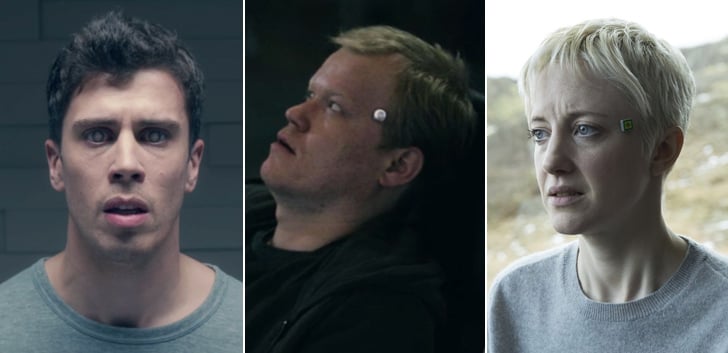 Image Source: Netflix [12]
Image Source: Netflix [12]
The Headpieces
In addition to the similar concepts of the DNA scanner and the cookie technology, there are physical clues that episodes share certain tech. In season one's "The Entire History of You," people have a memory implant in their brain that records everything they see, hear, and do. The way it looks and functions is just like the tech in season four's "Arkangel," which itself is reminiscent of the blocking/blurring tool in "White Christmas."
While those are both inside the brain, "USS Callister" and "San Junipero" have nearly identical, small white buttons that you affix to your temple. The button in season four's "Crocodile" is placed in the same spot, but grey and square-shaped. The headgear the protagonist in "Playtest" wears is pretty different — a halo, rather than a button — but seems to function the same way (on the temple, using electrical waves of some kind). If I had to guess, I'd say the order of the invention of these devices went as such: "Crocodile," "Playtest," "USS Callister," and finally, "San Junipero."
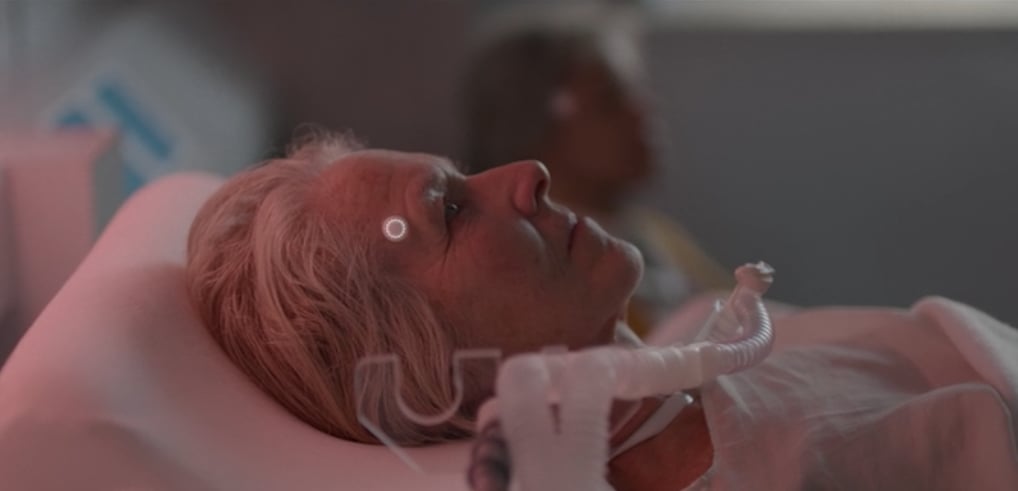 Image Source: Netflix [13]
Image Source: Netflix [13]
The Web of Season Two Connections
"White Christmas" doesn't only open the conversation about cookie technology, but also establishes that it's taking place in the same universe as fellow season two episodes "White Bear" and "The Waldo Moment," as well as season one's "The National Anthem." At one point later on in the episode, the character Potter (Rafe Spall) is watching a news clip about a deadly train crash. Below the main picture is a ticker that features three familiar names: Victoria Skillane, Liam Monroe, and Michael Callow. The first is the murderer terrorised in "White Bear"; the second is the frustrated politician who goes up against the talking blue emoji in "The Waldo Moment"; the third is the prime minister who is coerced into having sex with a pig in "The National Anthem." Oof.
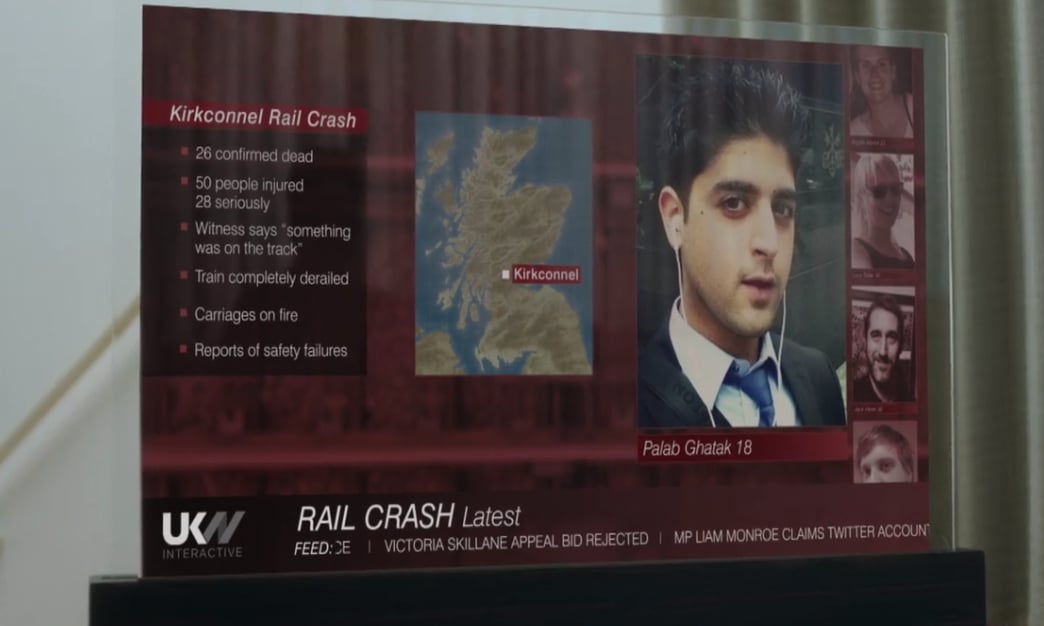 Image Source: Netflix [14]
Image Source: Netflix [14]
Additionally, the White Bear symbol is also seen on a jail cell door in this episode. Since we know cookie technology was created by Rolo, that means "The National Anthem," "White Christmas," "White Bear, "The Waldo Moment," "San Junipero," and "Black Museum" are definitively linked.
The Porn (Yes, the Porn!)
The heartbreaking season one episode "Fifteen Million Merits" is notable for plenty of reasons, but the fate of Jessica Brown Findlay's Abi is particularly horrific. After failing to impress the judges of a talent competition with her singing [15], Abi is basically forced into prostitution. She soon begins doing pornography for a channel called Wraith Babes.
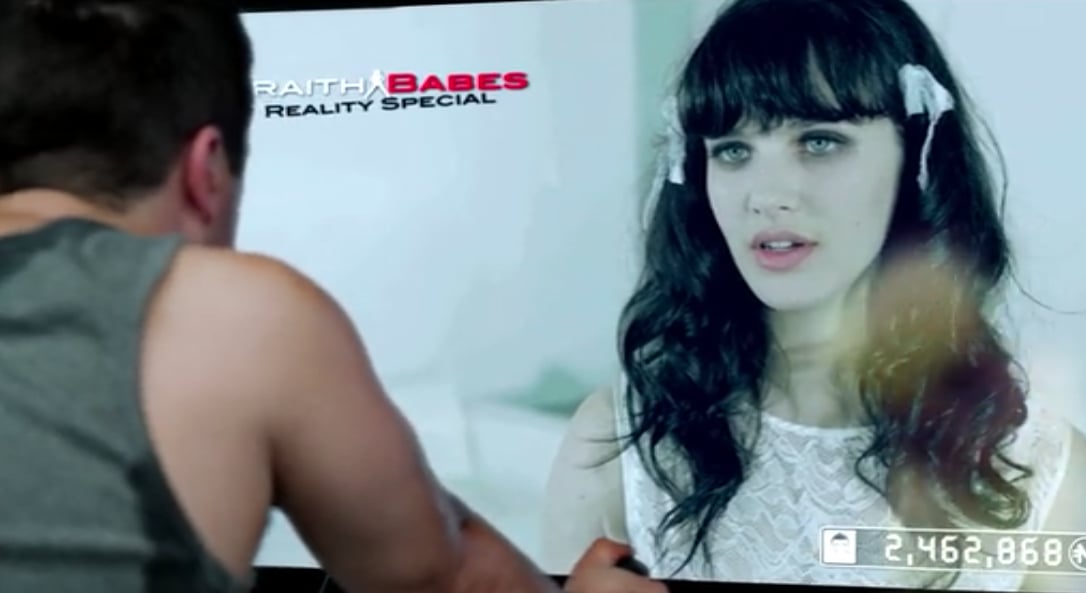 Image Source: Netflix [16]
Image Source: Netflix [16]
Flash forward to season four's "Crocodile" starring Andrea Riseborough, and you'll discover two bold connections to "Fifteen Million Merits." First is the song Abi sings during her audition, which plays over and over again throughout. Second is Wraith Babes. In an effort to prove she was in her hotel all night, Riseborough's Mia purchases an in-room adult film. She browses a selection of on-demand titles, one of which is from Abi's channel. See?
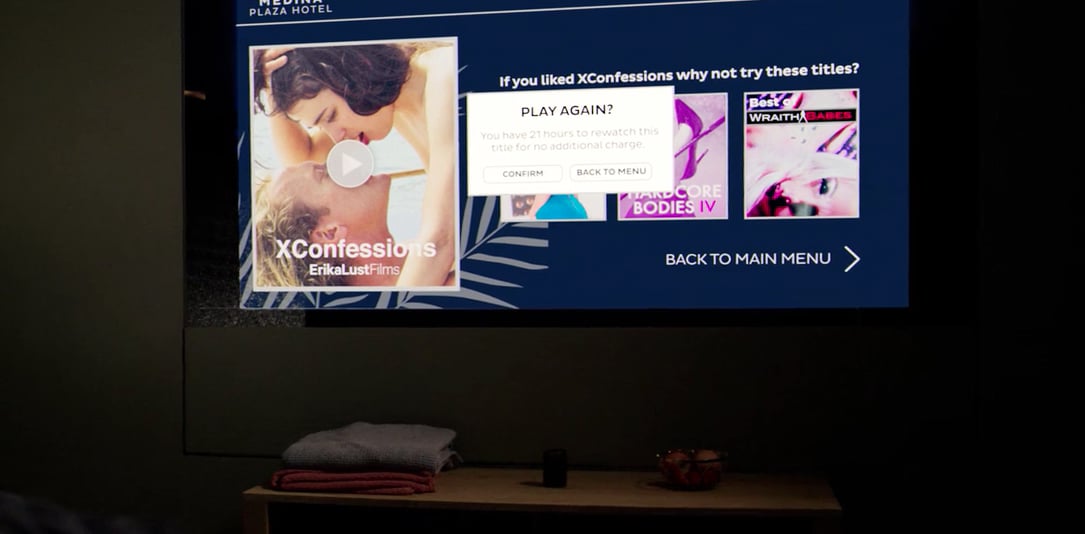 Image Source: Netflix [17]
Image Source: Netflix [17]
What's interesting is that "Crocodile" definitely seems to be taking place long before "Fifteen Million Merits" ever does, judging from the level of tech on display. This means the Wraith Babes pornography distributor has been around for a while.
The TCKR and "Metalhead" Conclusion
In the world of Black Mirror, it seems like everything boils down to the existence of TCKR. Both Rolo and the company itself have their hands in tech that pops up in tons of other episodes, and there's no telling what it eventually evolves into. But hold on a second — what if we already do?
If I had to generally arrange the episodes chronologically (again: generally), episodes like "Crocodile," "The National Anthem," "White Bear," and "The Waldo Moment" most likely take place earlier on. "Shut Up and Dance," "Nosedive," "Hated in the Nation," "Playtest," "USS Callister," and "Men Against Fire" probably happen sometime in the middle. Then, "Arkangel," "White Christmas," "The Entire History of You," "Be Right Back," "San Junipero," "Hang the DJ," "Fifteen Million Merits," "Black Museum," and finally, "Metalhead."
To be honest, everything has to end with "Metalhead." [18] This episode seems a bit innocuous at first, right? There's a very straightforward, bare-bones plot about a woman attempting to survive autonomous military "dog" robots in the barren wilds of the Scottish highlands; it's far and away the simplest story in Black Mirror's oeuvre. Dig a little deeper, though, and it starts to seem like "Metalhead" is the culmination of all the other episodes.
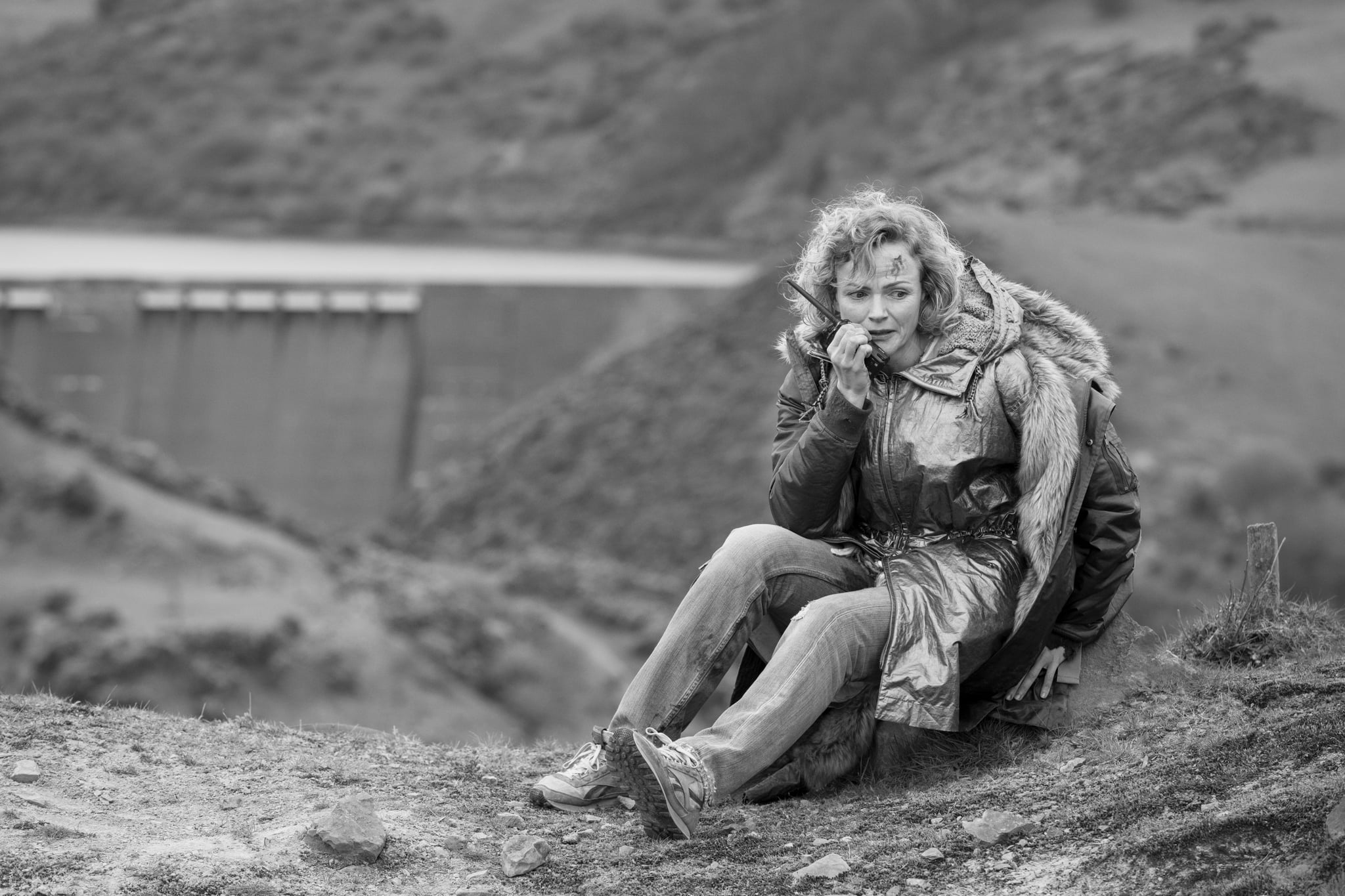 Image Source: Netflix [19]
Image Source: Netflix [19]
We know that the woman in the episode is part of a small group of humans low on supplies who have limited technology at their disposal (she uses a walkie-talkie throughout), and they have little-to-no means of evading the dogs. What if those dogs are a TCKR experiment gone wrong? They have white flashing charging lights that look suspiciously like the ones on the small temple buttons in "USS Callister" and "San Junipero." Not to mention, the dogs would easily fit in with the rest of TCKR's unethical futuristic projects.
Imagine this: the dogs were originally conceived of and sold by TCKR to help a police/government force wipe out certain dangers. But, after achieving autonomy, the dogs decided that humans would always be a threat (either to each other or the earth) and began wiping them out en masse, resulting in the bleak dystopia we see in "Metalhead" (similar to the drone insects in "Hated in the Nation"). After all, there's a card embossed with the San Junipero logo on it in a drawer that the woman in "Metalhead" ransacks, so that connects it to a ton of other episodes and storylines. It puts it toward the end of the Black Mirror chronological spectrum, as well. "Metalhead" could technically be the end of the show.
So, do you buy it? If so, great — I'll meet you in the craft aisle to buy more red string for my next conspiracy mood board. If not, at the very least, you have to admit that season four presents us with some undeniable connections.
